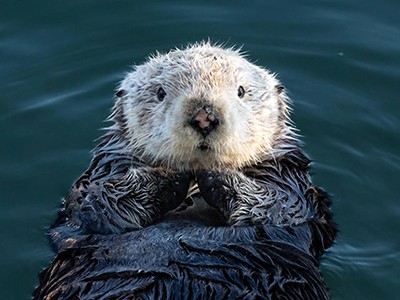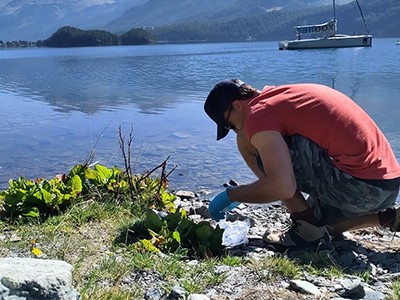[ad_1]
The intertidal is a conversation I join whenever the tides allow, negotiating with barnacle-covered rocks and rockweed for permission to enter. As a child, I ran across the beaches of the US central east coast with my grandfather, sand in my afro, marvelling at the tiny sand dollars dotting the shoreline. I could never have dreamed that, decades later, I’d be searching for their ‘cousins’ — sea urchins and starfish (also known as sea stars) — on the rocky beaches of the Pacific Northwest with the same enthusiasm, splaying myself across the rocks almost like I’m playing Twister. My ankles and my ecosystem knowledge grow stronger with every visit.
I’m a marine molecular ecologist, performing biodiversity assessments to help characterize how ecosystems are changing in a warming planet. These are physical endeavours that couple simple tools with complex ecosystem knowledge: location access, tide schedules and species recognition are just the beginning. But with techniques such as environmental DNA (eDNA) analysis, the situation has started to change. My colleagues and I can create site-specific species inventories using high-throughput genetic sequencing to analyse the DNA that every living organism sheds into its environment, using just a small sample of seawater.
How do otters protect salt marshes from erosion? Shellfishly
Such methods provide the almost-instant gratification of hard data. They help us make the intertidal zone accessible to those who haven’t experienced it. But eDNA inventories are only as strong as the — still limited — DNA reference libraries available. They also render moot the reason I’ve worked hard to know the difference between a gunnel and a prickleback, so I can identify fish before they zip out of sight. The more time we spend analysing at the bench, not the beach, the less connected we are to the ecosystems we are trying to protect. In an age of data abundance, I urge myself and other ecologists not to lose touch with the joy of the field.
This sense of connection is personal. As I’m seeing techniques change, I’m also seeing a changing of the guard. The field-hardened scientists — most of whom are male, and white — who taught me, in practice or through literature, are adding ‘emeritus’ to their titles, one by one. With them goes a wealth of knowledge and their history of belonging. I and my younger colleagues must now share our knowledge and foster a new, inclusive sense of belonging.
It is no secret that female scientists, especially those from historically under-represented backgrounds, are the most susceptible to fieldwork exclusion or harassment (A.-J. C. Demery and M. Avery Pipkin Nature Ecol. Evol. 5, 5–9; 2021). As one of just 2% of graduate students in Earth, atmospheric and ocean sciences who identify as Black (L. M. Isma et al. Oceanography 36, 56–59; 2023), I am used to being the only one, and having to explain and defend my presence in science and in the field. One of the attractions of the field is that my non-human kin don’t question my purpose there.
Creating a more inclusive, joyful feeling of belonging is the motivation behind the Yellow Island Intertidal Monitoring programme, a collaboratively developed project that I lead. It is sponsored by Black In Marine Science — an organization from which I have received mentorship, support and funding, and that I gratefully acknowledge — in partnership with a US non-profit organization, the Nature Conservancy. The programme’s team operates on a tiny islet of the San Juan archipelago in the Salish Sea, between Washington state and British Columbia, Canada, and seeks to understand how the region’s ecosystem is changing. The Yellow Island project comes with a template for an islet-specific species survey. A suite of student papers written in 2004 at the University of Washington Friday Harbor Laboratories under the guidance of Megan Dethier and Kevin Britton-Simmons provides a baseline for how the ecosystem looked two decades ago.
Why citizen scientists are gathering DNA from hundreds of lakes — on the same day
Every summer since 2022, participants have learnt about the islet’s species, completed surveys, obtained boating licences, practised science-communication skills and built a community. Hearing a student’s confidence in identifying organisms or their yelps of excitement when their favourite echinoderm burrows underneath the rock they flipped over (and back) is enough to invoke a sentimental attachment to the place — the bliss of belonging in a community bonded by the ecosystem and the science. I mean, who doesn’t want to touch a starfish?
We don’t ignore technology: the students work with both physical surveys and eDNA data. I’m optimistic that eDNA and the bioinformatic tools behind it can help to extend our community and, hopefully, our joy. It can corroborate the presence of some of the organisms the students physically counted, and add scores more.
Time in the field provides an opportunity to define a space not only for the students, but also for myself. It’s where I stand on the shoulders of my teachers to teach the next generation — where I share my interpretations and myself. This is a space where I can simultaneously be a molecular ecologist, a Black woman and a nerd for chitons: armoured snails that are exquisitely adept at contouring themselves to the shape of the islet’s rocks.
Conversation in the intertidal zone is punctuated with the pop of rockweed when you step on it. It’s full of the salacious secrets of anemones, and the whispers of stealthy mink slinking over the high tide line, looking for limpets to scrape free. This conversation is important to remind us that we are part of the world. Let’s not lose our ear for it.
Competing Interests
The author declares no competing interests.
[ad_2]
Source Article Link



